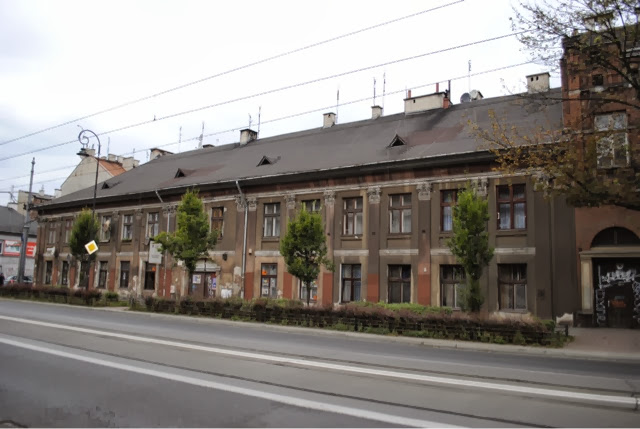The lady who worked there was very helpful in telling me about the many sites to go check out in Podgorze. In later days I was able to return and explore some of those places.
Here is a picture of the building where the museum is located. The museum is in the back part of the building.
Podgorze was founded in 1784 by the Austrian csar Joseph II. There were earlier settlements in this area around 10,000 years ago. In the Middle Ages this part of Poland was known for its stones, sand, coal and limestone. Later iron and tin were found here. From the 1830s Podgorze was developing fast as a city. It was an independent city and did not want to be added on to the city of Cracow.
The first electricity plant in Podgorze was built in 1899. It served the whole city and was on Nadwislanskiej street #4. This plant preceded the one built in Cracow (in Kazimierz).
The city government headquarters was located at #1 Rynek Podgorski. This later became the headquarters for the Jewish Council (Judenrat) during WWII.
In the 1920s other industry developed in Podgorze. Mills, bakeries, sugar and marmalade factories, and even chocolate factories appeared. It was a booming city.
An old cemetery (the old Podgorski cemetery) opened in 1775. Famous citizens of Pogorze were buried there, including Edward Dembowski (a leader of an uprising in 1846 for Poland's independence). I wrote about this place in a previous blog entry on Podgorze.
There are 3 main churches in Podgorze - sw. Benedykt, sw. Jozefa and Redemptorystow. (The 1st 2 I wrote about in previous blog entries. The 3rd one I did not visit.) Sw. Benedykt is only open for mass once a year on the Tues. after Easter when the Rekawka fair takes place. In the museum there is a photo of the church from 1941-43. Behind it is the ghetto wall.
In 1941 the Germans decided to build a ghetto in Podgorze. It was in the area between Krzemionka street, Rynek Podgorski, Plac Zgody (now Plac Bohaterow Getta) and Traugutta street. Liquidation of the ghetto was in 1943. From the ghetto prisoners were sent to Oswiecim (Auschwitz), Plaszow or Liban camps. The Liban camp was a forced labor place for Poles (a quarry). After the war it remained a quarry. In 1993 Steven Spielberg filmed part of Schindler's List here. Remainders of the sets are still on location (ie. barracks). I wrote about Liban in a previous blog entry.
There was a special exhibit on the area of Plaszow, where the labor camp was located. The mayor of Cracow Juliusz Leo wanted Plaszow to join Cracow and become part of Cracow. This was in the early 20th century. Cracow was interested in the industry and train transportation of goods in Plaszow. Plaszow refused multiple offers to join Cracow. One landowner in Plaszow Karol Czecz at first refused Cracow's offer to incorporate his land into Cracow. Eventually in 1910 he agreed to join his land to Cracow. Little by little Cracow was encroaching on Plaszow. Today it is considered a suburb of Cracow.
Lastly the Plac Niepodleglosci in Podgorze was an important place of resistance and fighting for Poland's independence. Today you cannot see any obvious evidence or reminder of this on the square, except for a sign and map there.

No comments:
Post a Comment